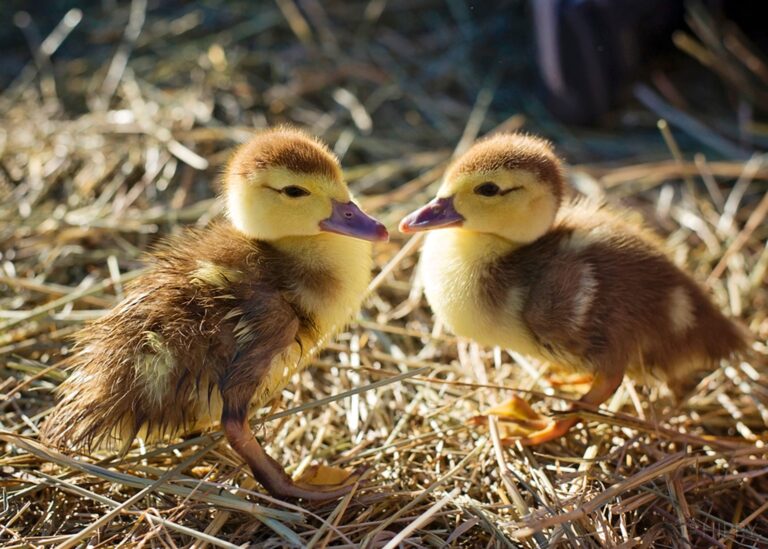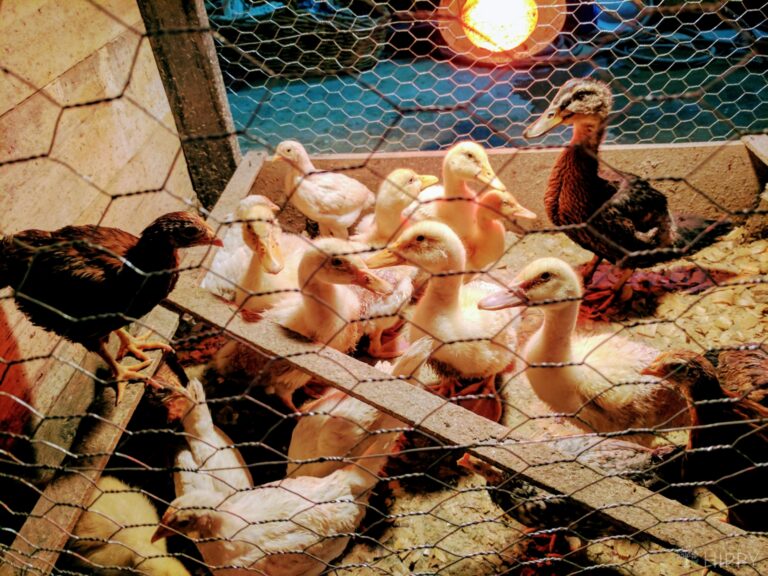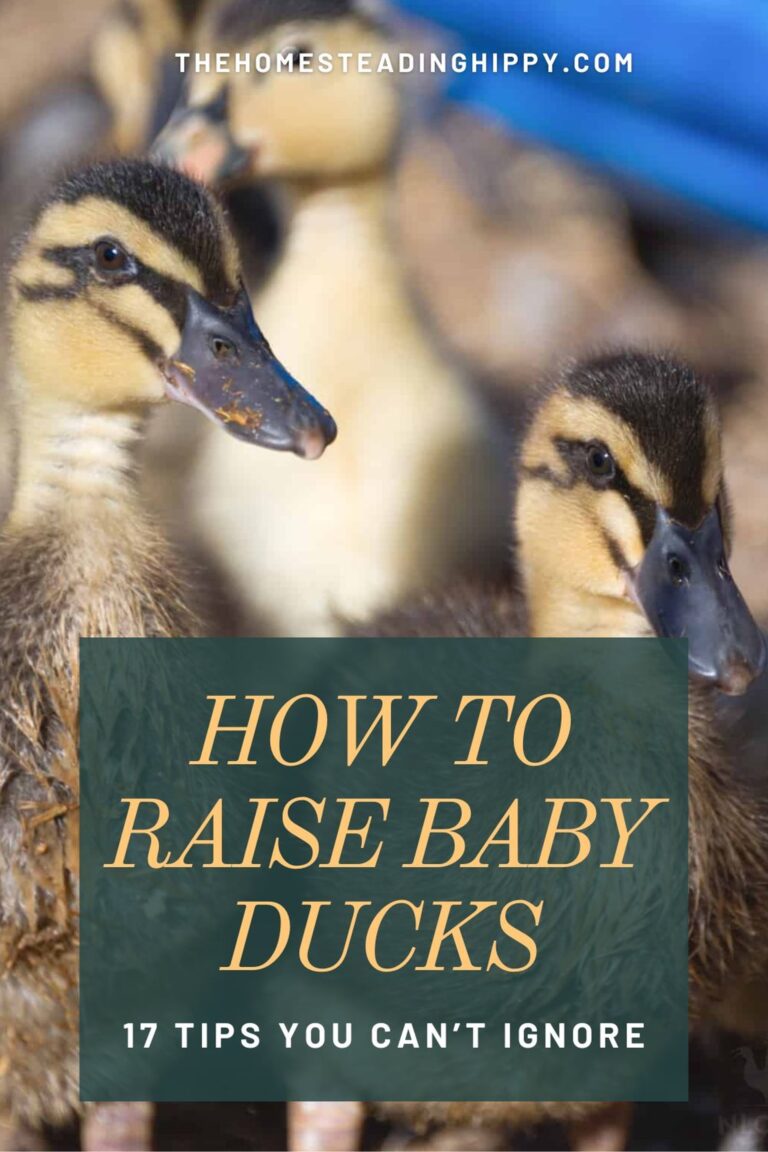Owning poultry is great, whether you want chickens or ducks. Lately, I’m all about the ducks: they lay just as many eggs as chickens if not more, and even better most will lay eggs right through the winter with no problems.

And, of course, if you’re expanding your flock the old-fashioned way or just bringing some home from your local farm supply store, that means you can look forward to utterly adorable baby ducklings.
Ducklings are incredibly cute but also incredibly vulnerable, and for first-time flock owners this makes raising them a pretty intimidating prospect.
What if you mess up? What if you accidentally hurt one of the little things?! It’s a terrible thing to consider, but don’t worry, because generations upon generations have done it and so can you.
To help you raise baby ducks the right way I’m bringing you 17 tried and true tips to keep them healthy and you sane!
Pick the Right Brooder Box
Once you have your baby ducks you’ve got to have a place to keep them, and you should really set this up before you do anything else.
Ducklings must stay in a brooder box, which is just a fancy term for any kind of enclosure that can keep them contained, keep them safe, and help keep them warm.
You have lots of choices here, from purpose-made solutions you can buy along with the ducks, but many seasoned duct keepers will raise ducklings in a large Tupperware tub, a clean, dry kiddie pool, a sturdy cardboard box, or even in an unused spare bathtub.
All have advantages, but I really like using the spare bathtub because it’s super easy to clean and drain when the time comes…
Line the Brooder with Bedding
Whatever kind of brooder you pick, your ducks have got to have bedding. This is the stuff that you line the bottom of the brooder box with to help it stay sanitary and also to help the ducklings stay warm.
Once again, you have choices…
You can use old, clean towels or T-shirts but I really prefer wood shavings, typically pine, that are specially made for the purpose. It’s more sanitary, easier to change, and helps keep odors down.
I highly recommend it, and if you’re going to spend a little bit extra on one thing, I say spend on a value pack of bedding to make your life easier.
Make Sure You Protect Ducklings from Drafts
Like I said above ducklings are incredibly fragile little animals, and one of the things they are most vulnerable to is cold. Even a sustained draft can make them sick and kill them!
For this reason, you need to do two things. The first is to put the brooder box in an area that is protected from drafts. A door you can close to stop the ingress of outside air is ideal, and you shouldn’t have any leaky windows or floors in there either.
The second thing is that you need tall walls around the brooder box. The top should be open, but you want at least a foot and a half on each side to help block drafts and keep the ducklings warm as they huddle together in the bottom.
Do this, in conjunction with a couple of other things on this list we’ll talk about in a second, and your ducklings will stay happy and comfortable.
Protect Ducklings from Pets and Little Children, Too!
One more thing that’s easy to forget and sometimes hard to accomplish is keeping your ducklings protected from any other pets you have and from little kids.
In the case of pets and other animals, I don’t care how tame your dog or cat is I promise you ducklings will activate their prey drive. That will end with disastrous and gory results that will have everybody in tears.
Even if you have an animal like another bird in the house or some kind of reptile, you can’t trust them around ducklings.
Also, little kids that won’t explicitly obey instructions can be too loud around ducklings and scare them, or handle them too roughly and hurt them. It’s always great to introduce kids to the joys of poultry, but they need supervision.
Make sure you can close off the area and secure it so no unwanted visitors can get to your ducklings and hurt or scare them.
Keep Ducklings Warm!
I’ve already mentioned how essential it is to keep ducklings protected from the cold, and to do that, you’ve actively got to keep them warm. They’re completely unable to fully regulate their body temperature like adults are, so it’s up to you to help.
To do this, you’ll need a special heat lamp and bulb. Chances are you’ll find these for sale right alongside baby ducks and related products at your local livestock or farm supply store. Set up the lamp over the brooder box, plug it in, and point it directly down into the box on one side.
Use a thermometer, which might not be included, to make sure the temperature on the floor of the brooder box is 90°F / 32°C. Be sure that ducklings still have room to get out from under the hotspot, because they can overheat.
That’s all you need to do to keep them warm for now, but we’ll be lowering this temperature in the coming days. More on that in just a minute…
Make Sure Your Ducklings Get the Right Starter Feed
Ducklings need the right kind of food because they have special nutritional requirements. To make things easy on yourself and ideal for them, you’ll want to buy them duckling starter feed, sometimes sold as early-life waterfowl feed.
It’s easy for ducklings to eat, easy for them to digest, and has absolutely everything they need to grow healthy and thrive.
They Can Eat Unmedicated Chick Feed in a Pinch
Now, let’s assume you can’t find any of this special feed I talked about in the previous tip, or that you’ve run out. And now your precious babies are hungry and quacking away! What do you do now?
Don’t panic: you can feed them chick feed in a pinch, which is sometimes similarly known as chick starter feed. Your ducks can easily digest it and will get nearly everything they need from it, so it’s a good emergency or backup option. However, there’s one major catch!
You must get an unmedicated blend. Ducklings eat a lot more food and a lot quicker than chicks do, and if you get them a medicated feed by accident, they will ingest a dangerous dose that is likely to kill them. Give unmedicated chick feed only, and only if you have to!
Use a Poultry Feeder for Best Results
You can give your ducklings their feed in a shallow bowl or tray, but you and they will be a lot happier with a poultry feeder, specifically one that is appropriately sized for ducklings.
The bottom line is that these feeders will help keep your feed dry and sanitary, and once you fill up the hopper, they automatically fill the feeding tray until the hopper runs out. They’re a lot more convenient for everyone involved and well worth the money.
Don’t Forget the Grit
Don’t forget that ducklings need grit in their diet in order to properly digest their food. Look at the ingredients on your duckling feed and see if it has grit included. If it doesn’t, you’ll need to provide it with the food.
You can use coarse dirt for the purpose, but considering how vulnerable ducklings are to getting sick, I suggest you use commercially available chick grit for the purpose. You won’t be worried about germs if you do that!
Ducklings Must Have Water to Drink… And Also to Eat!
Of course, your ducklings need food, and naturally, they also need water. But they don’t just need water to drink: your ducklings must have water in order to eat properly.
That’s right, your ducklings will grab a mouthful of food, dip their head in some water to moisten it, swish it around, and then swallow it all in one gulp to be digested.
I know what you’re thinking and yes, this tends to make a terrible mess. Nonetheless, provide them a constant supply of fresh, clean room temperature water at all times.

A Good Poultry Waterer is Indispensable
Just like with using a poultry feeder, a poultry waterer will help keep your ducklings and their brooder box a whole lot tidier and keep their food and bedding drier.
This is another cheap upgrade that is entirely worthwhile if you value your sanity. If you don’t want to spring for it, you can use a shallow pan or dish, just make sure it isn’t deep enough for your ducklings to swim in!
Change Out Wet Food and Bedding Frequently
Believe me when I say that your ducklings will get everything wet, constantly, and do so in very short order. That’s just the way it is, so be prepared to change out wet food and bedding whenever necessary.
Both will make ducklings cold, which must be avoided, and more importantly will begin to mold and rot which can make them devastatingly sick and is highly likely to kill them at this vulnerable stage.
Don’t wait, change it out.
Never Give Ducklings Access to Deep Water
This is the most counterintuitive tip on this list but arguably the most important. You cannot ever give your ducklings access to deep water, including a dish that is deep enough for them to swim in.
I know it sounds like the cutest thing imaginable watching them paddle across a tub or container full of water, but this is a great way to kill a baby duck.
For starters, they aren’t yet waterproof because they don’t have fully developed feathers or the natural oils necessary to make them buoyant. Second, when they get soaked, they will get chilled and that means their life will be in danger.
You just can’t risk it. Use a poultry waterer or a very shallow dish of water only. There will be plenty of time for splash-around fun once they are a little older.
Talk to and Handle Your Ducklings
This is the one tip I probably don’t need to remind you of because you’ll be doing it anyway. Make it a point to talk to, interact with, carefully handle, and touch your ducklings as much as possible.
Remember, these are domestic ducks, not wild ducks, and you want them to associate you and other people with good things. Your ducks can recognize you, you specifically: they’ll remember you, and they can remember many other faces besides.
This is a great way to forge a lifelong relationship with your ducks. It will bring you tons of joy, but it’ll also help your ducklings stay calm and grow up into properly socialized adults.
Ducklings Grow Quickly; Adjust Heat as Needed
Now, back to the heat issue. As ducklings grow, and they grow quickly, you’ll need to adjust the temperature in the brooder box.
This is both because their metabolisms kick up, generating more heat, and also because as their feathers develop they have better insulation. You don’t want them to overheat!
To avoid this, you need to lower the temperature inside the brooder preferably every day but at a minimum of once a week.
This should be a net 7°F decrease weekly, or about 1°F every single day. As always, make sure you leave room for the ducklings to get out from under the heat lamp.
After 5-6 weeks, your ducklings won’t need a heat source anymore unless it’s truly chilly, below 45°F / 7°C.
At 3-5 Weeks Old: Let Ducklings Go Outside On Mild Days
Once your baby ducks have grown up a little bit, and assuming they’re healthy, you can take them outside on short field trips so long as the weather is warm enough.
How can you tell it is warm enough? Check the forecast against how many days old your ducklings are: Simply subtract 1 for every day old that your ducklings are from 90. That is the minimum temperature (Fahrenheit) it must be to take them outside safely.
Take them out for a short field trip, then bring them back to the brooder.
At 7-9 Weeks: Fully Feathered and Ready to Go
I said your ducklings grow quickly, and they do, and depending on the breed once they’re anywhere from 7 to 9 weeks old they will be fully feathered and ready to go outside and join the flock so long as they have a good, well-insulated shelter.

Tom has built and remodeled homes, generated his own electricity, grown his own food and more, all in quest of remaining as independent of society as possible. Now he shares his experiences and hard-earned lessons with readers around the country.
Find out more about the team here.
